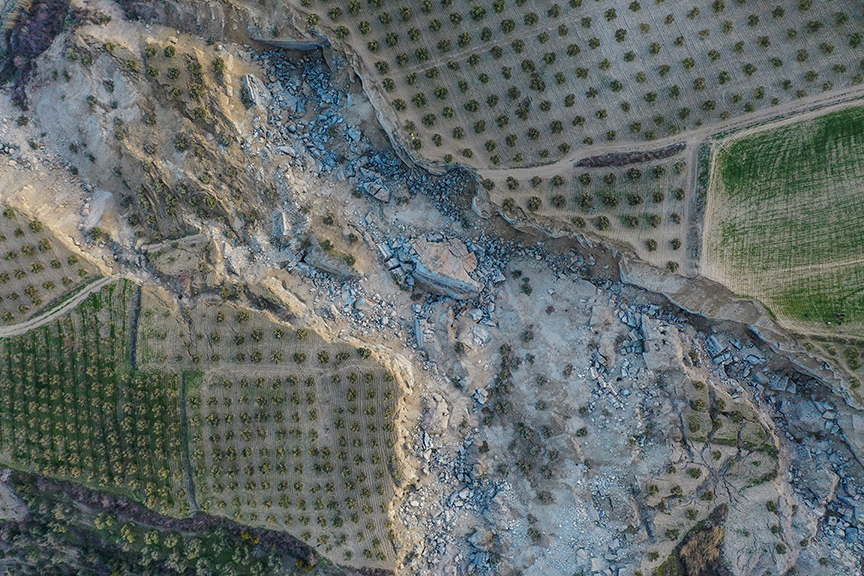On top of the long-term impact of climate change, the coronavirus pandemic started in 2020 and continued for approximately two years. Subsequently, the Russia-Ukraine war took a toll on agriculture and food supply security. Just as those negative repercussions were weakening, Türkiye experienced massive earthquakes – one of the worst disasters in world history – in winter conditions. The country was compelled to raise a Level 4 alarm to heal the wounds and request international assistance.
The “disaster of the century” featured a 7.7 magnitude earthquake in Pazarcık, Kahramanmaraş at 4.17 a.m. on February 6 and a 7.6 magnitude earthquake in Elbistan, Kahramanmaraş at 1:24 p.m. on the same day. Those tremors were followed by thousands of major and minor aftershocks. The twin earthquakes were not just high magnitude. They were also shallow – 8.6 kilometers and 7 kilometers deep, respectively. Unlike major earthquakes elsewhere, what happened in Türkiye was extremely close to the surface and thus much more destructive. As a matter of fact, the Anatolian peninsula shifted 3 meters westward due to the tremors. At the same time, the countless rifts and grikes, whose images have surfaced on social media, have revealed the disaster’s potential impact on agriculture.
The Earthquake’s Potential Impact on Agriculture
Due to the earthquakes’ magnitude, there may be delays and disruptions in agricultural production as well as damage to productive resources and difficulty accessing them. Moreover, earthquake-related landslides and cracks in agricultural areas may make it harder for farmers to grow crops in those places and could even stop their operations altogether. Furthermore, such developments in agricultural areas may cause damage to irrigation systems, including irrigation channels and pipes. Last but not least, earthquakes and their negative impact may trigger migration that disrupts agricultural production.
It is also important to recall that earthquakes tend to disrupt the production of herbal products and livestock, leading to delays or crop failures as well as the loss of harvested or stored crops and livestock. Furthermore, the alteration of plots could make it more challenging or altogether impossible to harvest crops. With animal feed ending up under the rubble, farmers may experience a shortage of feed as well. Last but not least, produce and livestock production methods, which rely on a steady supply of energy, may be significantly and negatively impacted by extended power cuts and the lack of access to fuel.
The negative impact of earthquakes on agriculture, in turn, may result in price hikes due to reductions or disruptions in produce and animal product supplies. Likewise, delays in any level of the food supply chain, including transportation, storage, processing, and wholesale or retail trading, may cause the loss of agricultural products and a sudden increase in food prices. Such developments may trigger food inflation and, by extension, general inflation.
The Disaster Zone’s Agricultural Potential
Each of the 11 provinces that the earthquakes affected has significant agricultural potential. Indeed, 3.6 million out of the 23.9 million hectares of agricultural land in Türkiye – approximately 15 percent – is located in the earthquake-stricken provinces of Şanlıurfa, Diyarbakır, and Adana. The number of registered agricultural enterprises and farmers in that region is approximately 270,000. Moreover, the relevant provinces account for approximately 20 percent of Türkiye’s total agricultural production and some 15 percent of its total livestock.
The total size of all plots where field crops (e.g. grains and other produce) are grown, in the earthquake-stricken provinces is approximately 2.6 million hectares – which corresponds to some 15.5 percent of the national total. Moreover, there are 110,000 hectares of vegetable production areas in those cities – 15.2 percent of Türkiye’s total vegetable fields. The quake zone also has 930 million hectares of land across the 11 provinces, where spices and plants for beverages are grown – 25 percent of the nation’s total relevant lands. Whereas Şanlıurfa, Diyarbakır, and Adana lead the production of arable crops, Adana and Hatay grow a significant supply of vegetables. Likewise, Gaziantep remains a major producer of fruit.
At the same time, the disaster zone accounts for approximately 20 percent of Türkiye’s agricultural and forestry exports – with Gaziantep single-handedly accounting for more than half of that region’s agricultural exports. Whereas the earthquake-stricken provinces generate approximately 9 percent of Türkiye’s gross domestic product, their share of the agricultural sector’s gross product reaches 14.3 percent. Those numbers indicate that the disaster zone’s dependence on agricultural income exceeds the national average.
How the Disaster of the Century Impacted Agriculture
At the time this article went to print, the earthquakes had claimed at least 45,000 lives. There is no available data on lives lost in the countryside. Nonetheless, reports from many rural communities and villages suggest that there were a significant number of victims in those places – despite some degree of variation across different provinces. It is possible that a significant amount of casualties among older citizens, who constitute a majority in the countryside and villages, will further decrease the already insufficient number of people working in agriculture and, consequently, result in a disruption of agricultural activity. Furthermore, citizens who lost their loved ones may not be able to work efficiently for some time due to the disaster’s psychological toll. In addition to the casualties, the earthquakes may encourage some citizens to relocate to other places due to the challenges of everyday life in the countryside and their emotional suffering.
It is important to note that the destruction of residential buildings as well as barns and other facilities killed livestock, damaged machinery, equipment and tools, and undermined the availability of seeds and animal feed by damaging stored supplies or reducing their quality. As such, farmers may experience temporary problems with the use of tractors, machinery, and other equipment as well as their feed and seed supplies. Moreover, there may be temporary diesel, fertilizer, seed, and insecticide shortages in March as agricultural production kicks off. Such developments, in turn, may lead to disruptions in plant production.
Since the earthquakes did not take place during the growing season, rural communities have not suffered losses due to the earth shifting or disruptions in the production cycle. Accordingly, food prices and the price of agricultural products may increase in a limited manner due to the loss of livestock and products stored in local facilities – since production itself was not affected. Unless the authorities actively enforce precautions taken for the next production cycle, however, the earthquake-struck region, which accounts for approximately 15 percent of Türkiye’s agricultural production, may experience disruptions in its production cycles, resulting in decreased output and soaring food inflation.
Agricultural Subsidies for the Earthquake Zone
The availability of tents, container homes, and temporary shelter in the countryside would encourage farmers and their families, whose homes are currently inhabitable, to remain in their villages. In addition to housing assistance, any steps taken to improve living and labor standards would prevent farmers from vacating the disaster-struck area and, by extension, any disruptions in agricultural production. In this context, the support of public authorities as well as nongovernmental organizations (NGOs), private citizens, and the international community is set to continue and is an important element on the ground. Likewise, the government’s delivery of emergency cash assistance (amounting to TL 15,000) to each affected family and pledge to support agricultural production have been hugely important.
The Turkish government has already announced that it will offer in-kind grants to farmers raising livestock in the 11 provinces and several other counties that the earthquake negatively affected. In this regard, the Ministry of Agriculture and Forestry will provide the lost equivalent of cattle, sheep, and goats free of charge to livestock producers, as much poultry to poultry farmers, and bees to beekeepers. Moreover, President Erdoğan issued a decree for the authorities to make a one-time delivery of feed per livestock until the end of 2023 for all cattle, sheep, and goat farmers in the earthquake-affected provinces. Finally, the authorities will immediately deliver enough sugar to approximately 12,000 beekeepers in those provinces for 1.483 million hives.
Furthermore, the Turkish government will make cash subsidies for fuel and fertilizers for the year 2023 to all farmers registered in the Farmer Registration System in provinces that suffered damage and have been designated part of the disaster zone. Cash payments will be made to the inheritors of farmers who died in the disaster if they apply to Ziraat Bank. Likewise, the Turkish Grain Board (Toprak Mahsulleri Ofisi, or TMO) announced that all products stored in licensed storage units damaged by the earthquakes were insured and stated that all registered farmers in the disaster zone could sell their grain and legumes to the Board without grade or quantity restrictions.
Predictions, Precautions, and Proposals
With the completion of post-disaster search and rescue operations, the authorities launched an intense effort to remove the rubble. Those operations are still underway. It is extremely important to recycle reusable parts of the rubble and prevent waste from contaminating the environment or underground water by placing it in suitable locations where it cannot harm agriculture. The authorities state that local governors diligently take necessary steps under the supervision of the Ministry of Environment, Urbanization, and Climate Change.
In the earthquake’s immediate aftermath, more than enough food was donated and delivered to survivors – in addition to all other forms of assistance. Assuming that such donations (especially aid from private citizens and nongovernmental organizations) will decrease over time and won’t be sustainable, the authorities put in place certain mechanisms to store excess goods to make it possible for local communities to use them in due time. It is equally important, however, to ensure the continuation of agricultural production in the disaster zone for the sake of that region and the entire country’s food supply security. Specifically, farmers must maintain crops and start planting in the spring.
Some farmers who engaged in agricultural production in the affected region lost their lives in the disaster. Others left the region due to poor living standards and being traumatized by the earthquakes. To stop and reverse that migratory trend, the authorities must urgently address the need for shelter, tractors, tools, and input in the countryside to create necessary working conditions. With the authorities attempting to provide shelter and food to affected communities as part of general relief operations, the Ministry of Agriculture and Forestry, together with the relevant government agencies, announced that they would provide additional support to farmers. Such assistance must continue until life goes back to normal.
There is a saying in Turkish that translates as “one good scare is worth more than good advice.” Accordingly, it is necessary to learn lessons from the latest earthquakes to improve rural living and working conditions in the disaster zone and across the country. Taking more advanced steps toward rural development for everyone in the countryside, not just people engaging in agricultural activities, is key to further increasing agricultural production to promote food supply security and attracting some city dwellers to rural areas. Such measures would contribute to “rural renewal” – the counterpart of urban renewal – and reduce earthquake-related losses in urban centers and the countryside.



